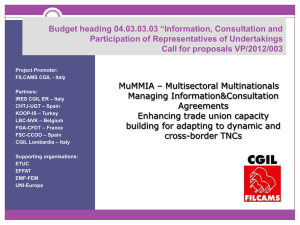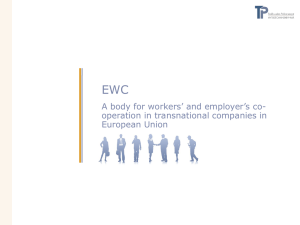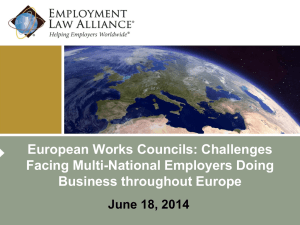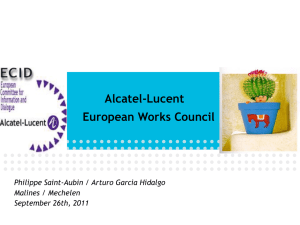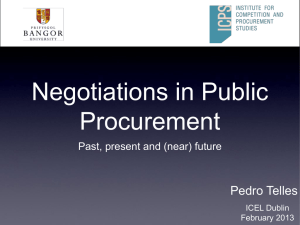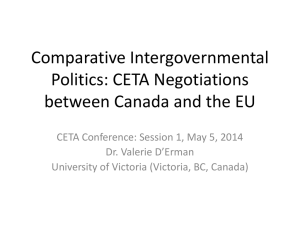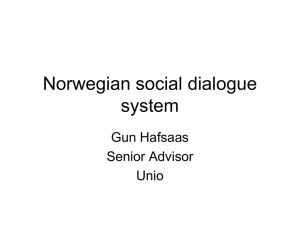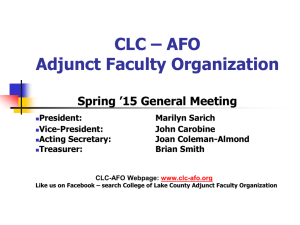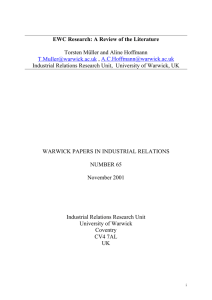First Experience with the new EWC Directive in Practice
advertisement
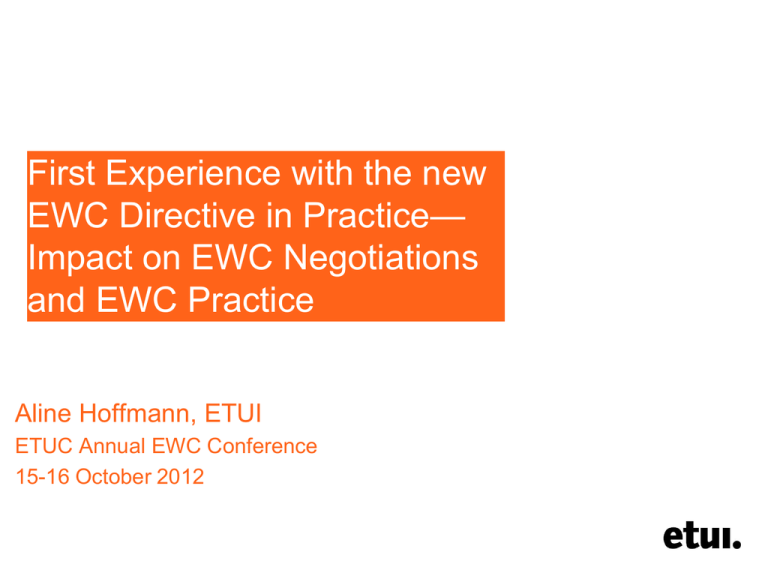
First Experience with the new EWC Directive in Practice— Impact on EWC Negotiations and EWC Practice Aline Hoffmann, ETUI ETUC Annual EWC Conference 15-16 October 2012 Overview 1. 2. A new wave of EWC negotiations First observable trends in new negotiations ● Especially new tendency towards EWCs according to the default provisions General trends in new EWC Agreements 4. Renegotiation of EWC Agreements under the Recast Directive 3. ● 5. 6. 7. 2 Implementing the provisions of Article 13 (new) on substantial structural change—some examples Effects of the Recast EWC Directive on existing EWCs Challenges for trade unions Questions for discussion EWC Negotiations occur in waves ● ● ● ● ● First big wave of EWC negotiations until 1996 (Pre-directive agreements) Second wave between 1996 and 2000 (first Article 6 Agreements) Third wave , although smaller since 2006: ● In medium-sized companies, (2000 – 10000 employees) ● Different company culture in SMEs ● More motivation required from trade unions to encourage the launch of negotiations. In remaining companies without EWCs, hesitation among employee representatives and unions due to ● Expected conflicts with employer ● Company culture which tends less to formalised agreements ● Complex structure of companies, often with HQ outside of Europe ● From 2008 onwards: expected new EWC legislation Since 2011 many new negotiations launched a new wave 3 Fußzeilentext hier eingeben New EWC negotiations since 2011 4 ● Example German metalworking industry: ● In German-based companies: 18 ● In non-German companies with sites in Germany 30 ● New agreements signed since 2011: 7 ● Initiatives from within and outside Germany ● Reasons given: ● In the economic crisis: more and more coercive comparisons of sites, more frequent transnational restructuring ● Greater need for cross-border cooperation perceived amongst employee representatives ● Impetus to formalise long-standing informal contacts in some companies ● The new EWC legislation offers better basis for cooperation ● Backlog of impending negotiations during transposition period A new wave of EWC negotiations ● ● Employee representatives and unions in smaller and „more difficult“ companies in some sectors are increasingly cooperating across borders Current negotiations concentrated in companies which –for whatever reasons—have not set up an EWC in the past 15 years. Entails special challenges to trade unions, etc ● ● ● ● ● ● 5 Highly complex structures don’t always “fit” well with conventional EWC standard structures and processes Lack of contacts between sites even at national level in complex companies Not always union presence everywhere Not always perception of relevant transnational interrelationships among employees Management often strongly opposed Content of new agreements is better due to significant improvements in recast Directive and effects of standards already set by EWC agreements in past years—continued and strong convergence First trends in new negotiations: more EWCs according to subsidiary requirements ● For example in the metal sector: ●at least four EWC on this basis in the last year alone, ●whereas until now there were only two in all in the metal sector and 12 in all sectors. ● Why suddenly EWCs according to subsidiary requirements ? ● Even if companies are not fundamentally opposed to EWC, parties shy away from costs of negotiations, especially if both parties do not see much manoeuvre to negotiate beyond (or below) the fallback provisions. ● In (most) other companies, in which an EWC according to the subsidiary requirements is the most likely outcome, it is because the companies are opposed to having an EWC, and drag out the negotiations 6 Increased tendency towards subsidiary requirements: a new situation for unions 7 ● Other issues are now at the core of EWC negotiations: ● Composition ● Substructures ● Articulation between levels ● Processes to operationalise the exercise of rights the opportunity to make the EWC fit the company and existing structures of workers’ representation better ● Unions always valued the negotiation process as such, as a way of fostering cross-border cooperation and providing a firm foundation for the work of the later EWC. ● However, new legislation provides for a far more sound basis for future work than did the former EWC Directive—but important gaps remain. ETUC EWC Conference, October 2012 Aline Hoffmann, ETUI Experience in current new negotiations ● In general: ● Definitions of information and consultation in line with recast Directive ● Clarification of transnational competence of EWC ○ ● Strengthening EWC members rights at national level ● Articulation between information and consultation processes at different levels (national – European) clarified ● 8 However, still frequent attempts to limit competence of EWC to (numerically) significant measures only Right to training ● Rules for renegotiation due to restructuring or other reasons (application of new Article 13) ● Persistent problem: smaller sites not represented , non-unionorganised sites Highlights in new EWC Agreements ● Differentiation between information rights on the one hand and consultation rights on the other, ● for example with clear reference to the effects of a measure on employment ● Articulation between levels defined to protect autonomy of all levels but still ensure meaningful consultation ● Right of access to sites for EWC members ● Strengthening consultation and maximising rights to involvement ● Right of EWC to put forward own opinion and the right to a further meeting to discuss this meeting/receive a reasoned response to that opinion before the final decision is made on a measure 9 ETUC EWC Conference, October 2012 Aline Hoffmann, ETUI Renegotiations in existing EWCs under the Recast EWC Directive ● A fast growing number of (article 6 and pre-directive Agreements) agreements are currently being renegotiated. ● ● 10 Even though the provisions of the Recast directive apply to all Article 6 agreements Reasons for renegotiations ● Mismatch between company structure and EWC arising over time or due to significant restructuring ● Desire to clarify the respective rights and obligations under the new Directive by putting them into an own agreement ● Pre-directive Agreements increasingly seek to take advantage of „significant structural change“ to base their EWCs on the new legislation by applying the provisions of Article 13 (new). ● However: Some reluctance among parties as well as unclarity about applicability and challenges on how to go about it in particular dealing with provision of 3 extra SNB members, which can bring unbalance geographical spread of mandates The new „Adaptation Clause“ in Article 13 (new) of the Recast Directive The new “adaption clause” applies to all EWCs from 2011 onwards i.e., “Article 13” and all “Article 6” EWCs If: ● ● ● significant change of company structure, and there are no adequate rules in agreement(s) affected, and there is a company initiative or request from two countries Then: ● new SNB negotiation rules applied including fallback rules ● SNB composition formula applied to all countries/sites affected ● plus 3 members of existing EWC(s) ● ● Old EWC(s) to remain in place until a new EWC agreement enters into force. Fallback regulations are new subsidiary requirements 11 ETUC EWC Conference, October 2012 Aline Hoffmann, ETUI Examples of renegotiations due to significant structural change: (possible) application of Article 13 (new) ● Carve-out of a small part of a very complex MNC: ● The 6 affected sites were (as a rule indirectly) represented in very large „Mother-EWC“. ● New negotiations launched under application of Article 13 (new) ● Old „Mother EWC“ to formally delegate its EWC mandate to the persons making up the new SNB ● Thereby ensuring that there is still an EWC in place during the course of new negotiations. 12 ETUC EWC Conference, October 2012 Aline Hoffmann, ETUI Examples of renegotiations due to significant structural change: (possible) application of Article 13 (new) ● 13 Merger of two similarly-sized companies, each with own EWC. ● Both had pre-directive Article 13 agreements ● New negotiations launched ● Some uncertainty about application of „3 extra members“ provision in Article 13 (new) ● Both agreements remain in force until new agreement is reached. ● Pragmatic approach to parallel EWC operation found with employer Examples of renegotiations due to significant structural change: (possible) application of Article 13 (new) Take-over of a large company (ca 2/3 of total future employment) by smaller company (1/3) ● Both have pre-directive/Article 13 EWCs. ● EWC of larger company wants new negotiations, ● EWC of smaller company want to keep their old agreement. ● Management wants to retain old agreement of smaller company. ● Different countries, different cultures, possible conflict between employee reps. ● Uncertainty about application of „3 extra members“ provision. 14 ETUC EWC Conference, October 2012 Aline Hoffmann, ETUI Examples of renegotiations due to significant structural change: (possible) application of Article 13 (new) How much room for improvisation? ● ● ● Two companies with Article 13 Agreements merge. Decision between EWCs and company to set up „SNB“ made up of select committees of the EWCs, rather than formal SNB procedure laid down in law. Legal basis of new agreement? Valid Article 6 only if negotiated by official SNB under application of Article 13 (new)? 15 ETUC EWC Conference, October 2012 Aline Hoffmann, ETUI Effects on existing EWCs ● ● ● ● EWCs which existed before the Recast Directive remain largely in their own traditions EWCs more confident, increasingly even considering legal action to enforce new rights, EWC taken more seriously as means to bridge gaps between worker participation in different countries. Whether new rights are being used or whether existing weaknesses persist depends on individual EWCs: ● EWC are flooded with information which is often irrelevant to their task as employee representatives ● EWCs as extension of (dominant) national industrial relations culture and practice ● Working conditions for EWCs are still insufficient and limit the emergence of a genuinely European and competent body 16 Challenges for trade unions ● ● ● 17 Actively develop articulation of information and consultation processes between national and European levels ● making better use of information and opportunities to join forces and agree common strategies ● It is not a zero-sum game... Use new rights ● information and consultation ● insist on transnational competence of EWCs in line with new directive ● Insist on relevant management counterpart, meaningful consultation ● improved definitions can help EWC to ensure that their rights are upheld and respected ● Right to training and “means necessary” ● develop offers, support EWCs in developing their own tailor-made approaches and work programmes on specific issues Further improve support and coordination: ● among trade unions represented in the company and the EWC, within EWCs, between EWCs Some Questions for Discussion… ● What other experiences are there in other sectors with negotiations/renegotiations under the Recast EWC Directive ● How do EWCs perceive the impact of the new rules and definitions in the Recast Directive? ● Why do Article 13 EWCs seem reluctant to invoke the right to new negotiations under the Recast Art 13? 18 ETUC EWC Conference, October 2012 Aline Hoffmann, ETUI EWC bodies currently active, by category of employment in EEA 19 R. Jagodzinski © etui (2012) Informia II final conference: EWCs as an opportunity for I&C rights EWC bodies currently active, by category of internationalisation (number of EEA countries in which the companies have operations) 20 R. Jagodzinski © etui (2012) Informia II final conference: EWCs as an opportunity for I&C rights
